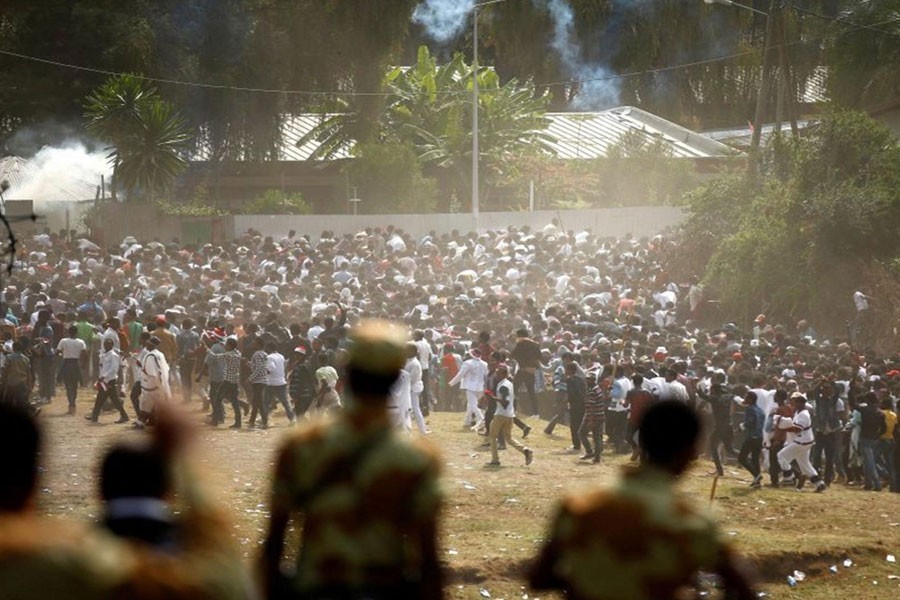
Published :
Updated :

Treating a class of people with ethnic bias by another self-styled superior group has been part of social systems since early civilisations. These practices reached their distressing height in the Nazi German-occupied Europe during the World War-II. This and other racial and cultural profiling and carrying out of pogroms led to the mushrooming of Hitler's ghettos, concentration camps like Auschwitz-II in German-occupied Poland, cold-blooded killings --- and finally the Holocaust across Europe. In fact, the mass killings of ethnic adversariesbegan in WW-I. Western historians call them 'brutal genocides'. In the following times, 'genocides', 'ethnic cleansing', 'racial profiling' etc became part of human societies.
With the onset of the 20th century, many of the powerful democratic states, to their horror, began discovering skeletons in the cupboard. As they are democracies and claim themselves to be open societies, they did not hesitate to disclose their dirty secrets to the media. In this noble task, the civil society plays a supreme role --- mostly with government nod.
Thus the people of modern Canada came to learn about a terrible phase lurking in their history. The revelation has shocked the world, not to speak of the country's government and the platforms engaged in activities aimed at saving the rights of Canada's Indian aboriginal peoples. Discovery of the indigenous people's ruins of settlements, human cages-turned-torture chambers etc was a frequent scenario in the north and south Americas throughout the 19th and 20th centuries. Even against this backdrop, the Canadian discovery has proved incredulous to many. The North American country, long under British imperial rule and its colonial supervision, hasn't seen much planned killings of its native Indians. But the programme of Indian child students' relocation to white 'civilised schools', and later, the reign of terror let loose on the children, followed by their killings, now runs the risk of remaining a blot on Canada's history of peaceful co-existence with its indigenous populations. The persecution campaign in the name of reform took place between 1831 and 1996. Blamed on the time's government, and certain church groups, the schools' aim was to assimilate aboriginal children with the mainstream society.
Upon hearing the news from the global media a week ago, the saner segments of the world must have visualised the revolting scenes of beastly tortures inflicted on the 215 children forcibly taken away from their parental families. What took the grisly episode to its barbaric height was the killing of these children, some as young as three years old. According to detailed reports, the proof of the 'cultural genocide' came to light after the remains of the 215 children were found at the former Kamloops Indian Residential School in Vancouver in Canada's British Columbia. In the period from 1831 to 1996, Canada's residential school system forcibly separated around 150,000 children from their homes and subjected them to punishments ranging from abuse, sexual harassment to malnutrition at schools around the country. The report is prepared by the Truth and Reconciliation Commission in 2015. The commission used the term 'cultural genocide' to define the ethnic cleansing-centric campaign. The only offence the children had committed was they came from indigenous families.
History, especially the phases in the 18th-19th-20th centuries, is replete with over a dozen localised ethnic extermination campaigns or blatant genocides. Most of them occurred during and after sanguinary wars. But genocidal killings have also vitiated the times of peace. Those are normally perpetrated by thevengeful ruling cliques, or sections of masses nurturing an ethnically skewed demon in their subconscious. A continuously persecuted ethnic group rising in revolt is also part of history. The key-factor behind a long oppressed group's becoming overwhelmingly dominant in a national landscape is its strong unity. These racially oppressed peoples have been seen revolting against the oppressors. Many term these acts 'rebellion', due to their strength being seeking of justice --- not revenge. The humiliating defeat of erstwhile Pakistani forces by Bangladesh's heroic Bengalees is such a glaring instance in the 20th century. However, these heroic sagas are soaked in blood.In gaining independence from the Pakistani invaders, the Bengalee nation had to lose three million of its Liberation Fighters and general people.
Ethnic superiority and dominance over the minorities --- mostly natives, has been a common feature of history. The countries which only hundred years ago rolled out the welcome mat to the world's luckless, battered people should feel embarrassed as they are reminded of the brutal treatment they once meted out to their indigenous or native peoples. These peoples, long on fast decline, include the American Indians and the Black slaves in the US, the Aboriginal Australians, the native Maoris in European-dominated New Zealand and many other smaller ethnic groups in even East Asian countries. On the other hand, genocides are still taking place intermittently. The 20th century has been blighted by ethnic cleansing and genocide in Croatia, Bosnia and Rwanda --- not to speak of Bangladesh.
There is, however, good news. In the modern world, the ethnic cleansing ought to have long been declared oxymoron. It hasn't happened. But ethnic hostilities have started disappearing from the face of earth. Humans are now busy with many basic problems, the latest being the Covid-19 pandemic. In their desperate struggle to save themselves, ethnic hostilities have little space. As for the aboriginals, they are fast thinning out or getting assimilated with the mainstream population.


 For all latest news, follow The Financial Express Google News channel.
For all latest news, follow The Financial Express Google News channel.